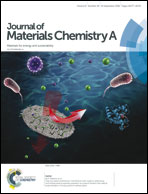A flexible comb electrode triboelectric–electret nanogenerator with separated microfibers for a self-powered position, motion direction and acceleration tracking sensor†
Abstract
In this paper, we report a flexible comb electrode triboelectric–electret coupling nanogenerator using a separated friction microfiber object for self-powered position, motion direction and acceleration tracking sensing and its energy harvesting. The power was generated from the coupling of the electrostatic and triboelectric effects among a separated triboelectric object, a polytetrafluoroethylene (PTFE) film and interdigital electrodes. Under an acceleration of 1 m s−2, we found that the corona charged PTFE film with a sliding motion reached ∼3 times more short-circuit current (Isc) and ∼6 times more open-circuit voltage (Voc) than the PTFE film without corona charges, respectively. The device can be a good self-powered acceleration tracking sensor, where the reasons were a stability voltage out during the process of separated components frictions and a numerical relationship of Isc with increased accelerations. Moreover, potential applications using several different separated materials such as a bulk of carbon microfibers, a finger sliding with a nylon glove, and water microdrops were used to show the energy harvesting of various friction materials and their effective contact area. It was found that a much larger contact area “finger” sliding showed a Voc of ∼45 V, whereas a smaller contact area “microdrop” sliding on the prototype presented a maximum peak Voc of ∼1.8 V.



 Please wait while we load your content...
Please wait while we load your content...